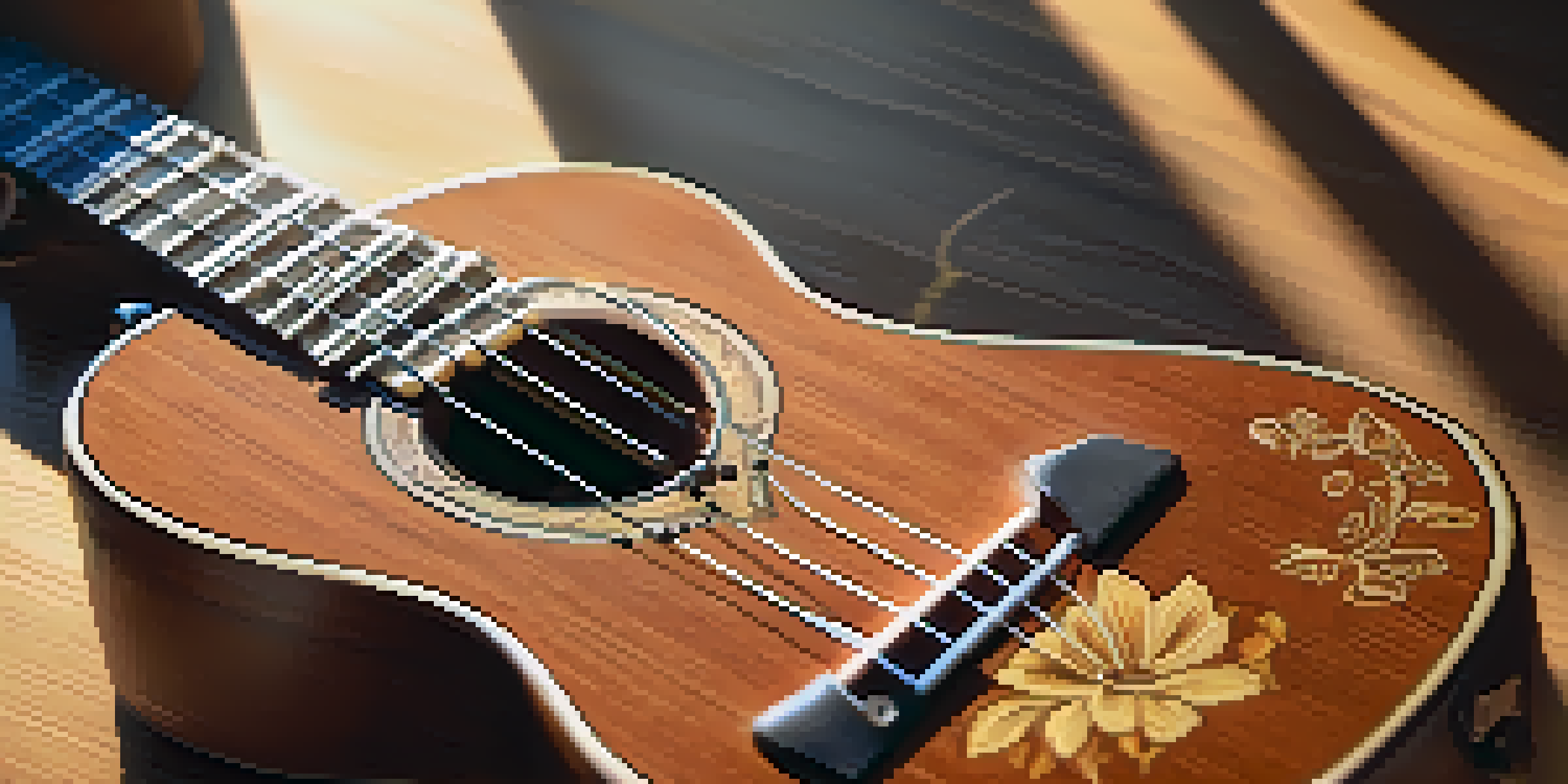Using Dynamics to Elevate Your Acoustic Ukulele Performance

Understanding Dynamics in Music Performance
Dynamics in music refers to the variations in loudness between notes or sections. It plays a crucial role in adding emotion and depth to your performance, making it more engaging for your audience. In the context of playing the acoustic ukulele, mastering dynamics can elevate your overall sound and expressiveness.
Music is the shorthand of emotion.
For instance, think of a gentle breeze versus a powerful storm; both are sounds of nature but evoke different feelings. Similarly, varying your playing dynamics can shift the mood of your ukulele piece, transforming a simple melody into a compelling performance.
By focusing on dynamics, you can create contrasts that capture listeners' attention, making your music resonate on a deeper level. This understanding is the first step in enhancing your acoustic ukulele skills.
The Importance of Volume Control
Volume control is fundamental to achieving dynamic range in your music. It involves playing some notes softly while others are played more forcefully, allowing for a richer listening experience. Practicing volume control can help you develop a more nuanced sound on your acoustic ukulele.

Imagine telling a story; if you spoke in the same tone throughout, it would quickly lose interest. However, by varying your volume—whispering during suspenseful moments and raising your voice during climaxes—you keep your audience engaged. The same principle applies to your ukulele playing.
Mastering Dynamics Enhances Emotion
Understanding and applying dynamics in music can significantly elevate the emotional depth of your ukulele performances.
To practice volume control, try playing a simple chord progression and experiment with different dynamics. This exercise not only improves your technical skills but also enhances your musical storytelling.
Techniques for Practicing Dynamics
Practicing dynamics can be as simple as focusing on specific exercises that target volume variation. One effective technique is to play scales or chords at different volumes, gradually increasing and decreasing your intensity. This method helps you gain better control over your instrument and develop a keen ear for dynamics.
The more you know about music, the more you can express yourself in it.
Another useful exercise is to record yourself playing. Listening back can reveal areas where your dynamics may be lacking or where you might be overdoing it. This self-reflection is vital for improvement and helps you understand how dynamics can change the feel of your music.
Incorporating dynamics into your practice routine will not only make your playing more expressive but also increase your overall musicianship.
Exploring Crescendo and Decrescendo Techniques
Crescendo and decrescendo are essential dynamics techniques that help you build and release tension in your music. A crescendo involves gradually increasing volume, while a decrescendo entails a gradual decrease. These techniques can add dramatic flair to your acoustic ukulele performances.
For example, imagine strumming a soft chord and gradually increasing the intensity until you reach a powerful strum. This technique can captivate your audience and create an emotional journey within your music. Conversely, a decrescendo can evoke a sense of calm or introspection, allowing listeners to reflect on the piece.
Volume Control Creates Musical Nuance
Practicing volume control allows musicians to create a richer, more engaging listening experience by varying intensity.
Experimenting with crescendos and decrescendos in your practice can lead to more dynamic and memorable performances.
Incorporating Dynamics into Song Repertoire
When choosing songs for your acoustic ukulele repertoire, consider how you can apply dynamics to enhance the music. Some songs may naturally lend themselves to dynamic contrasts, while others may require innovative interpretation. Analyzing a piece for its dynamic potential can transform how you approach it.
For instance, a ballad may benefit from softer sections that build into powerful choruses, while an upbeat song might utilize quick dynamic shifts to keep the energy high. By incorporating dynamics into your arrangements, you can create your unique interpretation that stands out.
This creative process not only challenges you as a musician but also invites your audience into a more immersive experience.
Using Body Language to Enhance Dynamics
Your body language can significantly impact how dynamics are perceived during a performance. Subtle movements, such as leaning into the instrument when playing softly or swaying with the music during crescendos, can amplify the emotional delivery of your piece. Engaging your audience visually can deepen their connection to your music.
Think of a theatrical performance: actors use gestures and facial expressions to convey emotions. Similarly, by consciously using your body, you can enhance the dynamics of your ukulele performance, making it more relatable and engaging.
Body Language Boosts Performance Impact
Using body language effectively during performances can amplify the perception of dynamics and engage the audience more deeply.
Practicing in front of a mirror can help you become more aware of your body language, allowing you to refine your stage presence and further elevate your performances.
The Role of Dynamics in Audience Engagement
Dynamics play a crucial role in keeping your audience engaged during a performance. By varying your volume and intensity, you can evoke emotions and maintain interest throughout your piece. An engaged audience is more likely to connect with your music, making the performance more rewarding for both you and them.
Consider a concert where the artist alternates between soft, intimate moments and loud, energetic sections. This ebb and flow of dynamics can create a captivating atmosphere, drawing listeners in and inspiring them to feel alongside you.

Incorporating dynamics into your performance strategy allows you to create memorable experiences for your audience, ensuring that your music leaves a lasting impact.